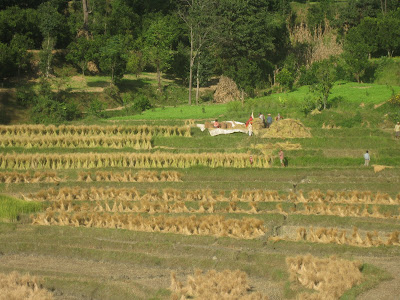
image: rice harvest outside Panauti, Kavrepalanchowk, Nepal
the greetings and solicitations shouted your way whenever you (tall, white) venture out of the city:
"hallo!"
"whatisyour name?"
"hello how are you!"
"take one photo please"
"yes give me please one sweet"
* * *
Fall comes to the Nepalese middle hills as a chill in the air at night, days now pleasantly warm and sunny. Cherimoyas are done and suntala (tangerines? mandarins?) are starting to blush gold. Time to eat black dal (heavy and warming) and to sun-dry hot peppers, strips of daikon radish, and the fermented greens called gundruk against the coming chill. A proverb refers to the "min pachas," 50 days and nights when even the fish are frozen in place in this land's swift-flowing rivers.
I think of New England fall days, tumbling towards solstice more dramatically than they do here. Walking with a Nepali friend to Namobuddha, a really extremely old stupa a day's walk from the Valley, I tried the capture the feeling of our Northeastern autumn: the colors, I said, and the slant of the light... you, reading this at a northerly latitude, understand.
But how to evoke to you the feel of the rice harvest in the villages? The terraces, meticulously laced one-by-one with emerald shoots back in June when the monsoons provided the necessary ankle-deep mud--the paddy in the terraces is now ripened to golden brown. The plants have been tied into bunches (with other rice stalks for ties) for weeks, and after cutting and threshing with a foot-powered spinning device the empty bunches of straw are left in place to dry (see photo). The rice, still in husk, is spread out on pieces of plastic or cloth tarps, combed through, fanned with circular woven bamboo trays called nanglo to blow away bits of foreign matter. One man or woman hurling nanglos full of spiraling, shining rice onto the tarp, two or three fanning with their own nanglos, thrrrepp-swoosh-swoosh, a steady rhythm. Every step of this work is accomplished with whole families working together, long days in the sunny fields as slowly the gold stalks give way to bare brown, the stubble and the hut-like straw piles the only signs left of the months of labor. Hard to conceive of the amount of sweat that went into every luxuriant spread of husked rice, like the queen-sized mattress-sized amount that the old woman is combing through with her bare feet, taking her time as she pores through the fruits of her labor.
Kinds of rice. There's mansuri and its various subtypes for everyday eating, fat-grained tai cin (preferred for chiura, beaten rice, and chang, milky rice beer) but an unreliable producer, prone to pests and disease), prized pokhreli and jira masino ("fine cumin-seed"). Some seed is heirloom, some new-fangled hybrid that yields higher or is more resistant to disease but that, surely, takes its toll even on the rich lakebed clay soil of the Kathmandu Valley. I don't know if genetically-engineered rice has made its way here yet, with its double-talk promises and price to match. Most farmers probably couldn't afford the initial outlay, and I hope they would refrain from taking loans and risking their lands to do so (though many here, Newars of the Jyapu caste, are tenants working others' fields and receiving 50% of the harvest). It's a topic for another entry, better yet a more politically and economically-astute writer--but the trend away from subsistence and towards commodity agriculture looks to me like a dangerous one. I'm highly suspicious of the global free market...but better quit while I'm ahead on this subject. The argument for primeval or pictureque poverty isn't a pretty one either. But--one last protest--before TV arrived here, no one complained that their lifestyle wasn't up to the Western 'standard of living.'
Now that I've put my foot in it--comments welcome.

No comments:
Post a Comment